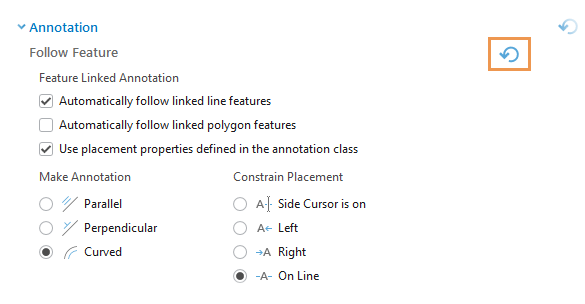Application options for annotation include default settings for tools that create or modify follow feature annotation such as the Annotation editing tool  and the Follow Feature construction tool
and the Follow Feature construction tool  .
.
To change annotation options, complete the following steps:
- Click the ribbon Edit tab and click the Options dialog box launcher
 in the Manage Edits group.
in the Manage Edits group.Tip:
When you create annotation features with the Follow Feature construction tool
 , or modify annotation with the Annotation editing tool
, or modify annotation with the Annotation editing tool  , you can right-click the map and choose Follow Feature Options
, you can right-click the map and choose Follow Feature Options  or press O to change these settings.
or press O to change these settings.The Options dialog box appears.
- Click the Editing side tab and expand Annotation.
- In the Feature Linked Annotation section, enable or disable the following settings:
Automatically follow linked line features
Feature-linked annotation automatically follows the contours of its related line features. This is turned on by default.
Automatically follow linked polygon features
Feature-linked annotation automatically follows the contours of its related polygon features.
Use placement properties defined in the annotation class
To see which relationship class is associated with an annotation feature class, right-click the feature class in the Catalog pane, click Properties
 , and click Relationships.
, and click Relationships. - In the Make Annotation section, choose one of the following alignment settings:
Parallel

Create straight annotation that is aligned parallel to the feature. As you create new annotation, you can switch this to perpendicular on the toolbar.
Perpendicular

Create straight annotation that is aligned perpendicular to the feature.
Curved

Create curved annotation that follows the contours of the feature.
This setting disables Parallel/Perpendicular
 , which appears on the toolbar.
, which appears on the toolbar. - In the Constrain Placement section, choose one of the following constraint settings:
Side cursor is on

Dynamically constrain annotation to follow the pointer as you hover to either side of a segment.
This setting disables Left/Right
 , which appears on the toolbar.
, which appears on the toolbar.Left

Constrain annotation to the left side of the feature, based on the direction of the segment.
Right

Constrain annotation to the right side of the feature, based on the direction of the segment.
On Line

Constrain annotation centered on the feature segment.
This setting disables Left/Right
 , which appears on the toolbar.
, which appears on the toolbar. - To reset Follow Feature options to the default settings, click Reset
 .
.
- Click OK.
Your settings are saved and the dialog box closes.